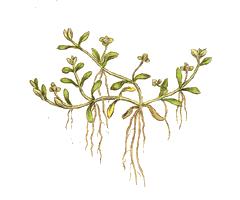Difference between revisions of "Elatinaceae"
Jump to navigation
Jump to search
m (1 revision: E+F angiosperm families #1) |
(inedible family) |
||
| Line 16: | Line 16: | ||
}} | }} | ||
| − | + | {{Inedible family}} | |
| − | |||
| − | |||
| − | |||
| − | |||
==References== | ==References== | ||
{{reflist}} | {{reflist}} | ||
| − | + | {{Ack-Wikipedia}} | |
| − | |||
| − | |||
| − | |||
[[Category:Malpighiales families]] | [[Category:Malpighiales families]] | ||
Revision as of 13:32, 5 June 2017
| Elatinaceae | |
|---|---|

| |
| Elatine hexandra | |
| Scientific classification | |
| Kingdom: | |
| (unranked): | |
| (unranked): | |
| (unranked): | |
| Order: | |
| Family: | Elatinaceae |
| Genera | |
Elatinaceae is a family of plants with no known edible members.
References
- ↑ Angiosperm Phylogeny Group (2009). "An update of the Angiosperm Phylogeny Group classification for the orders and families of flowering plants: APG III" (PDF). Botanical Journal of the Linnean Society. 161 (2): 105–121. doi:10.1111/j.1095-8339.2009.00996.x. Retrieved 2013-07-06.
Acknowledgements
This article uses material from the Wikipedia article Elatinaceae, which is released under the Creative Commons Attribution-Share-Alike License 3.0.